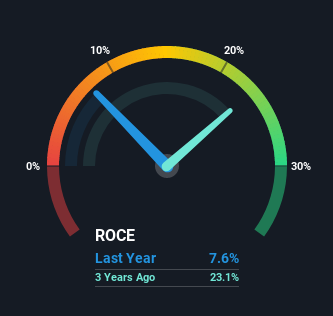- France
- /
- Professional Services
- /
- ENXTPA:ALDLS
Investors Could Be Concerned With DLSI's (EPA:ALDLS) Returns On Capital
There are a few key trends to look for if we want to identify the next multi-bagger. Ideally, a business will show two trends; firstly a growing return on capital employed (ROCE) and secondly, an increasing amount of capital employed. Ultimately, this demonstrates that it's a business that is reinvesting profits at increasing rates of return. However, after briefly looking over the numbers, we don't think DLSI (EPA:ALDLS) has the makings of a multi-bagger going forward, but let's have a look at why that may be.
Return On Capital Employed (ROCE): What is it?
For those who don't know, ROCE is a measure of a company's yearly pre-tax profit (its return), relative to the capital employed in the business. Analysts use this formula to calculate it for DLSI:
Return on Capital Employed = Earnings Before Interest and Tax (EBIT) ÷ (Total Assets - Current Liabilities)
0.076 = €4.5m ÷ (€112m - €53m) (Based on the trailing twelve months to June 2021).
Thus, DLSI has an ROCE of 7.6%. Ultimately, that's a low return and it under-performs the Professional Services industry average of 14%.
View our latest analysis for DLSI

Historical performance is a great place to start when researching a stock so above you can see the gauge for DLSI's ROCE against it's prior returns. If you want to delve into the historical earnings, revenue and cash flow of DLSI, check out these free graphs here.
What Does the ROCE Trend For DLSI Tell Us?
When we looked at the ROCE trend at DLSI, we didn't gain much confidence. Over the last five years, returns on capital have decreased to 7.6% from 30% five years ago. Meanwhile, the business is utilizing more capital but this hasn't moved the needle much in terms of sales in the past 12 months, so this could reflect longer term investments. It's worth keeping an eye on the company's earnings from here on to see if these investments do end up contributing to the bottom line.
On a related note, DLSI has decreased its current liabilities to 48% of total assets. So we could link some of this to the decrease in ROCE. What's more, this can reduce some aspects of risk to the business because now the company's suppliers or short-term creditors are funding less of its operations. Since the business is basically funding more of its operations with it's own money, you could argue this has made the business less efficient at generating ROCE. Keep in mind 48% is still pretty high, so those risks are still somewhat prevalent.
In Conclusion...
To conclude, we've found that DLSI is reinvesting in the business, but returns have been falling. And investors appear hesitant that the trends will pick up because the stock has fallen 36% in the last five years. In any case, the stock doesn't have these traits of a multi-bagger discussed above, so if that's what you're looking for, we think you'd have more luck elsewhere.
On a final note, we found 2 warning signs for DLSI (1 shouldn't be ignored) you should be aware of.
While DLSI isn't earning the highest return, check out this free list of companies that are earning high returns on equity with solid balance sheets.
New: Manage All Your Stock Portfolios in One Place
We've created the ultimate portfolio companion for stock investors, and it's free.
• Connect an unlimited number of Portfolios and see your total in one currency
• Be alerted to new Warning Signs or Risks via email or mobile
• Track the Fair Value of your stocks
Have feedback on this article? Concerned about the content? Get in touch with us directly. Alternatively, email editorial-team (at) simplywallst.com.
This article by Simply Wall St is general in nature. We provide commentary based on historical data and analyst forecasts only using an unbiased methodology and our articles are not intended to be financial advice. It does not constitute a recommendation to buy or sell any stock, and does not take account of your objectives, or your financial situation. We aim to bring you long-term focused analysis driven by fundamental data. Note that our analysis may not factor in the latest price-sensitive company announcements or qualitative material. Simply Wall St has no position in any stocks mentioned.
About ENXTPA:ALDLS
DLSI
Provides employment solutions in France, Germany, Switzerland, Luxembourg, and rest of the European Union.
Flawless balance sheet with slight risk.
Market Insights
Community Narratives



